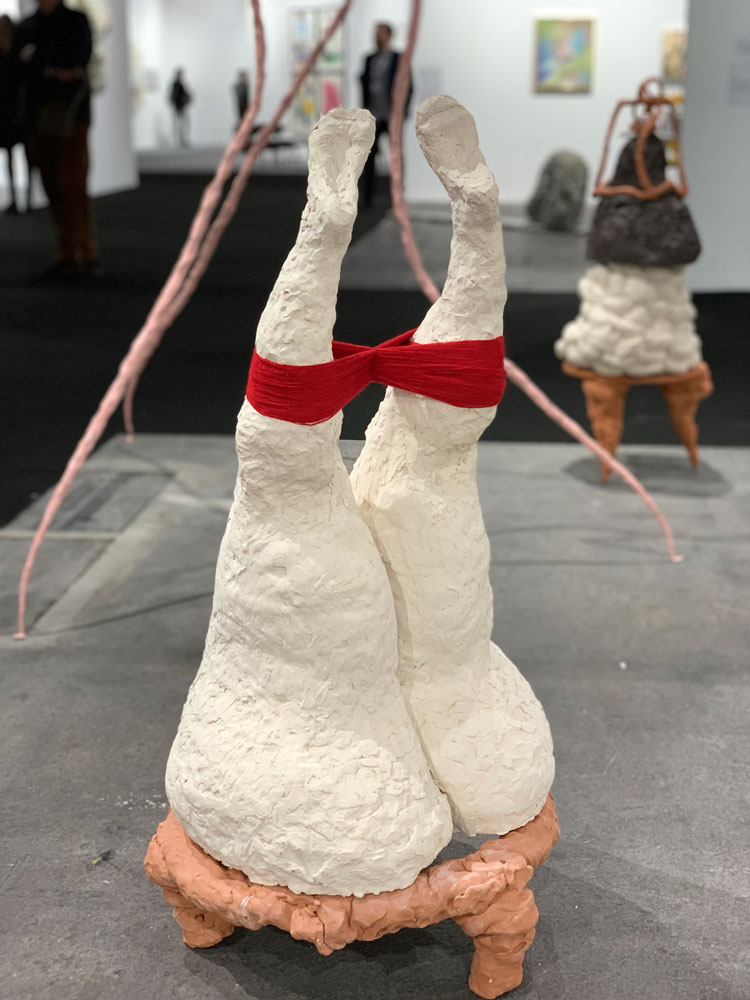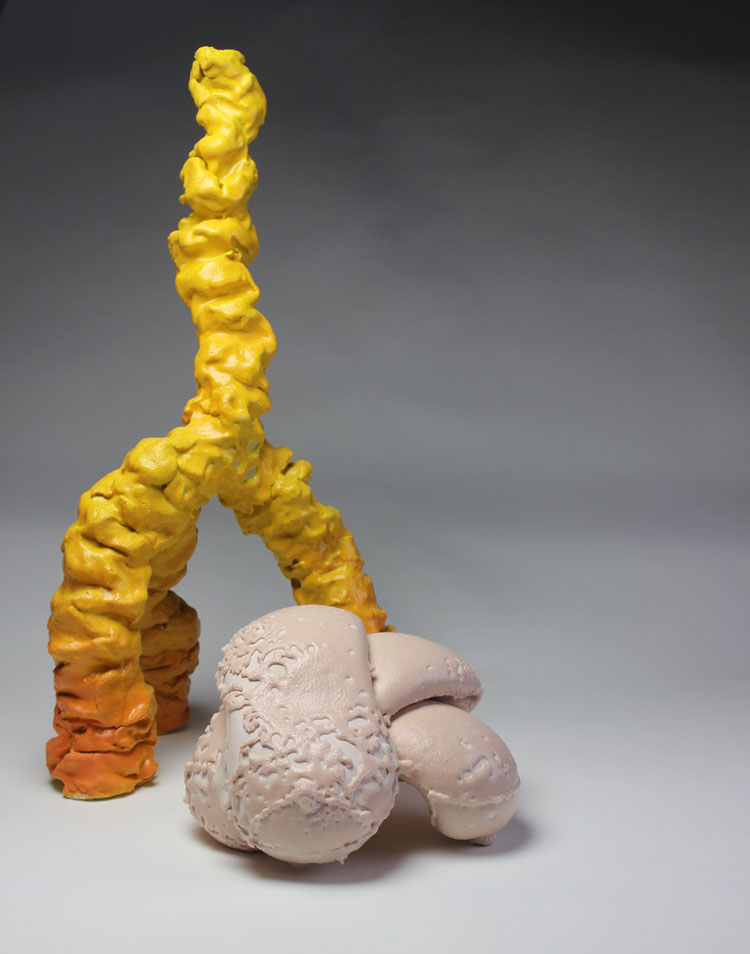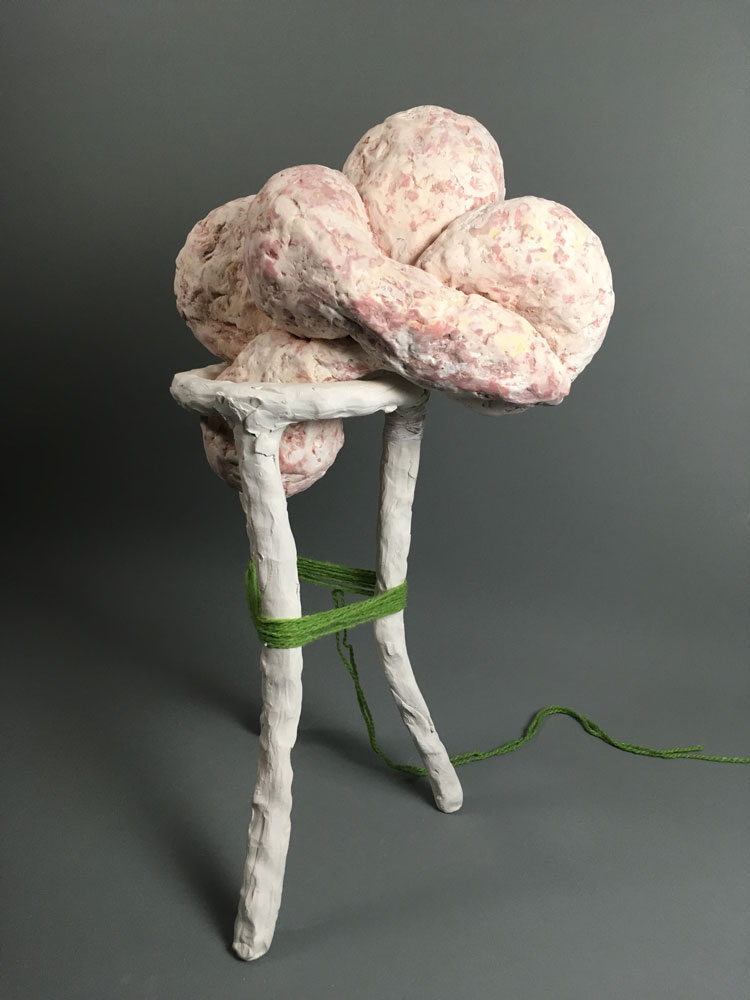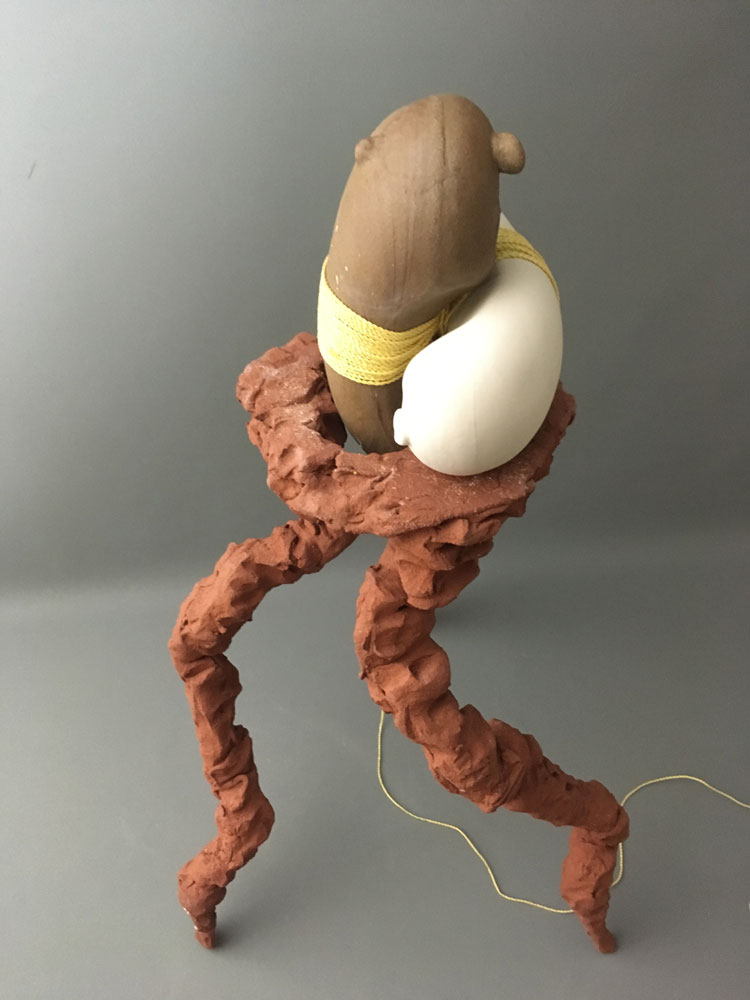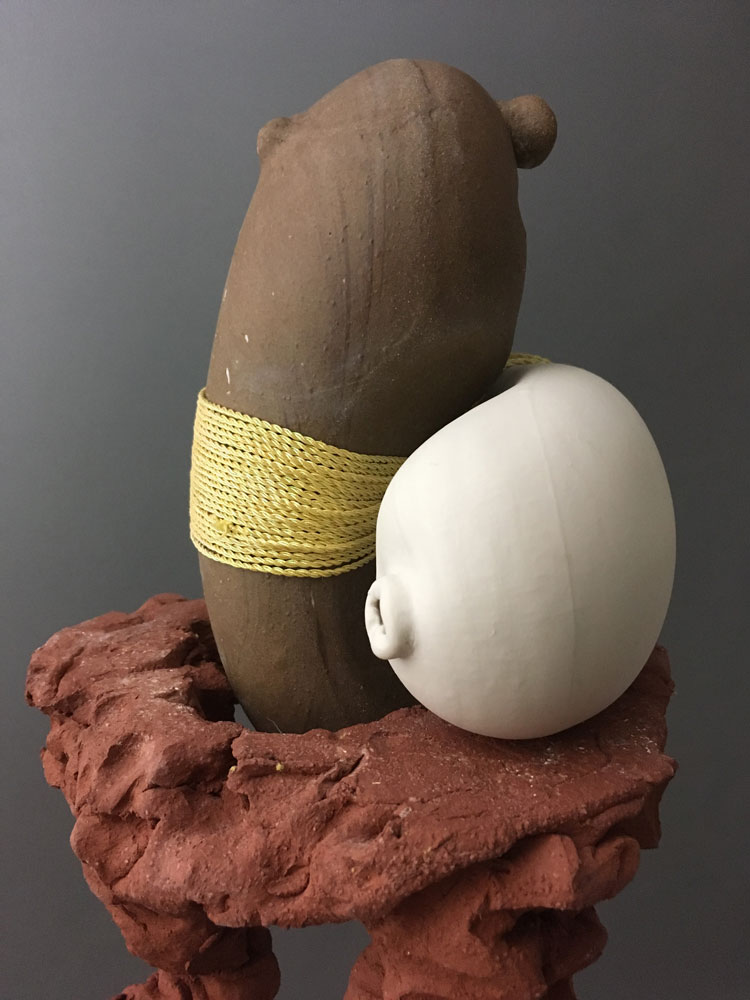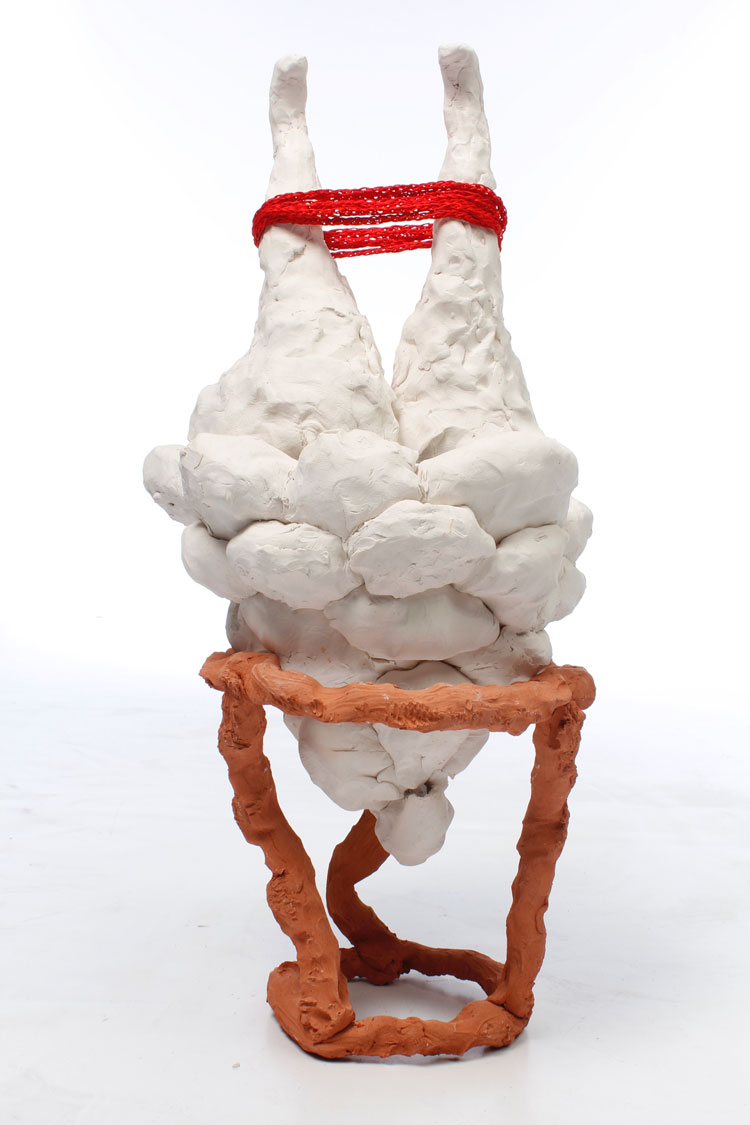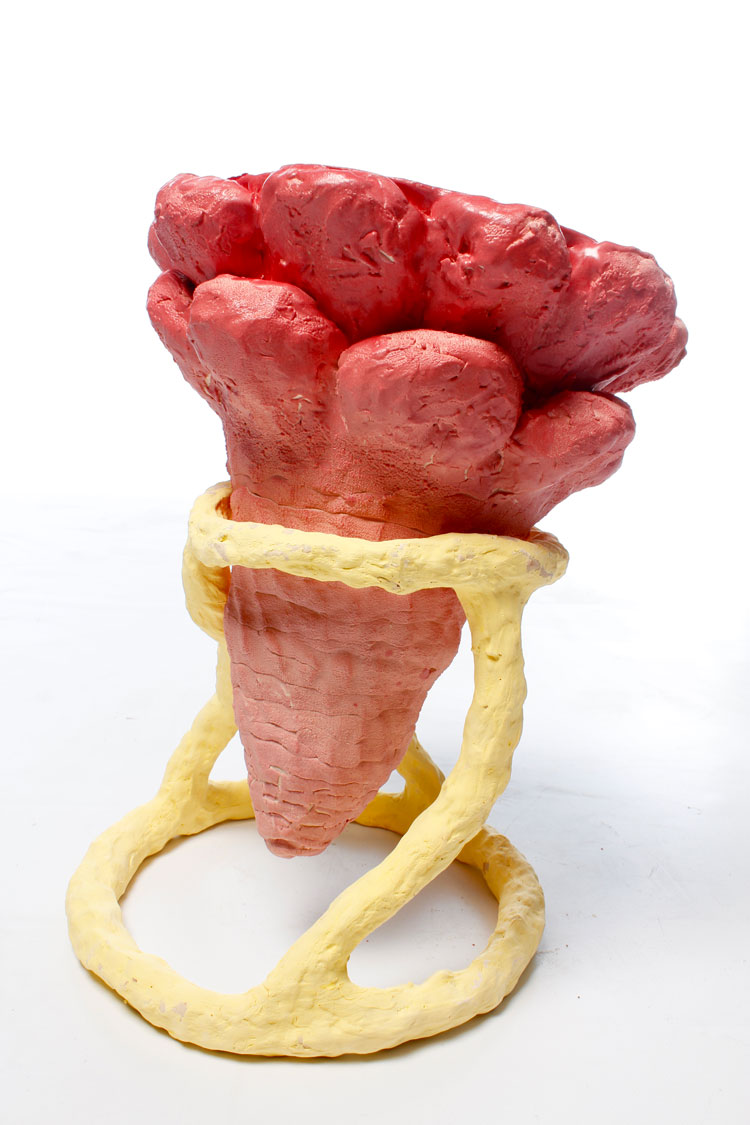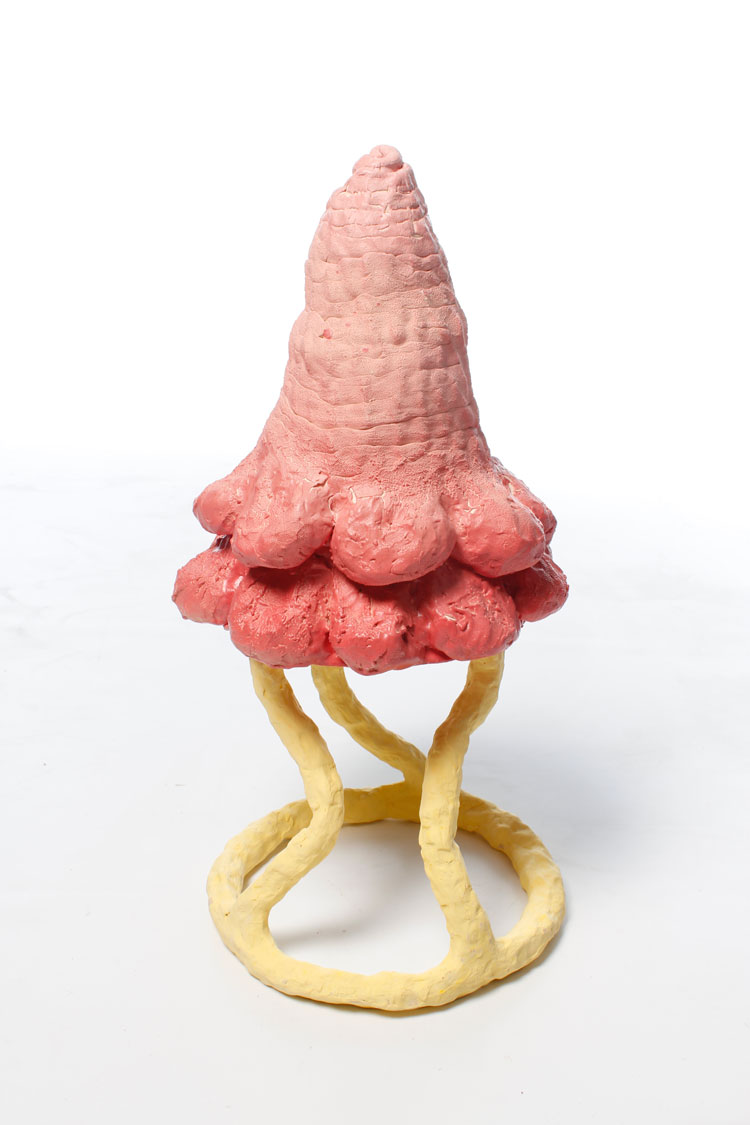

by VERONICA SIMPSON
My first sighting of the sculptural ceramics of Sam Lucas (b1967, Cheltenham), at the British Ceramics Biennial (BCB) in Stoke, in September 2019, made a big impression. I was struck by the seductive, or occasionally repellent, skin-like qualities she conjures from the clay and its firing processes, the way in which she combines these textures and forms to create sculptures that vibrate with life, almost human but also alien: here a mound of pale and fleshy, pimpled sex organs looking vulnerable and sweaty beneath a green cage; there a pair of upended, voluptuous legs, their calves entwined with underwear-ish red straps. Clay has rarely been so saucy, so suggestive, playful and yet vulnerable. It was obvious why Lucas was among the handful of artists selected from more than 150 applicants for the BCB’s prestigious Award 2019, receiving a grant towards new, commissioned work that was then exhibited at the biennial. And thanks to the BCB, she was invited to appear at Taste Contemporary, at ArtGenève this January, which led to an appearance at La Fonderie Kugler, Geneva.
[image8]
Now, she is emerging from lockdown with new work for a fascinating exhibition hosted by Professor Jörg Wiedenmann of the National Oceanography Centre at the University of Southampton, based on PhD research into coral bleaching. Featuring the work of a local artist collective, Vulgar Earth, the show, Bleached (which will open later this summer, at God’s House Tower, Southampton, although a firm deadline has yet to be confirmed), aims to raise awareness of the alarming impacts of global warming and pollution on our coral reefs. The term refers to the fact that healthy coral’s natural hue ranges between green and brown; the explosive pinks and oranges for which coral is celebrated as a precious material are, in fact, signs of a kind of toxic shock – a transition state, terminating in its white, bleached condition.
[image5]
Lucas’s first experience of handling clay was in her “troubled teens”. While struggling with the ambitious, academic curriculum at Pate’s grammar school for girls in Cheltenham, she fell under the guidance of artist/teacher Rod Ashman, and the art department and its clay rooms and kilns became her sanctuary. Her preoccupation with the fragility, qualities and substance of the human form, however, she attributes in part to her immensely capable single mother, a dressmaker whom she and her sister often accompanied on visits to clients. These trips must have reinforced a sense of the female body as something that has to be hidden, masked, cloaked, corsetted or revealed strategically according to occasion, body shape or the intended audience. Having an uncle with cerebral palsy, she says, also gave her a sense “that bodies don’t always do what they are meant to. Displacement within your own skin isn’t only geographical.”
Lucas went to Cardiff School of Art, where she was drawn to sculpture, but her love of clay clashed with the prevailing opinion of the time, that clay was not a fine art material. She refused to give it up. After graduating, she travelled, spending time in France and then India, where she lost weight – as people tend to do. That sense of a new body emerging in her 20s was also disorientating, inspiring a series of works that tapped into body anxiety, eating disorders and body dysmorphia and expressed through hollow, distorted fleshy limbs that appeared like armour. An interest in how the mind works led her to art therapy, and she has worked for the last 20 years in the creative arts department at the National Star College in Cheltenham, which caters for people with complex needs. In 2016, she returned to Cardiff School of Art to complete an MA in fine art ceramics, graduating in 2018.
[image2]
Lucas was selected to be part of the Crafts Council artist development programme Hothouse 2020. She will appear in early 2021 in an exhibition at Contemporary Applied Arts, London, accompanying a book on contemporary British ceramics by Ashley Thorpe, in which a chapter is dedicated to Lucas.
Veronica Simpson: What is it about clay as a material that keeps inspiring you?
Sam Lucas: The malleability, the freedom to make whatever the clay leads me to make, intuitively. I was inspired by the great French thinker Hélène Cixous’ idea of “embodied knowledge”. I interpret this in my own way: that we are storage houses for all of our experiences of life and learning. When we create, we are allowing ourselves to be the vessels from which this knowledge comes: the body as a frame from which we experience the world, carrying knowledge, histories of equal measure to the mind. I make many objects at one time, in different clays and different scales. I need a fairly large space to work so that I can build up a kind of language of forms, a vocabulary of objects, and then the deadline generally helps me to assimilate and construct the characters from the objects. At this stage, there is a childish humour involved in the process, I like to place objects together to explore the ambiguous connections between these figurative forms. I like it when they make me giggle.
I do not start with a definitive idea or visualisation of the finished pieces. It is an organic process and can be quite nerve-racking. I work quickly and anxiously, leaving the traces of my actions and finger marks. The work can be described as sloppy, but it has soul and humour and encourages the viewer to make up their own mind about what or who these ambiguous figures may be.
[image4]
I do not always know who they are at first, as they come from deep within my psyche. It is from spending time with them that they sometimes reveal themselves to me, laughing with or at me.
During the making process, there is an endless internal dialogue, a narrative that seems to come from within my body. The human condition is bountiful and infinite. I have always felt myself to be “socially awkward”. Emotions and experiences in the social world are limitless and baffling to me, so I am always questioning, hoping to find the answers in the clay or the thoughts that are released and revealed during the sensory process. Louise Bourgeois described the practice as “technologies of the self”, constantly recreating the self.
I often return to a favourite quote from Spinoza: “Every body, person, fly, stone, comes with a thing called conatus or drive to seek alliances with other bodies that enhance its vitality.”
[image3]
VS: Why do you think clay has such therapeutic power?
SL: Clay as a material has properties that naturally lend themselves to being therapeutic. It has a malleability that emulates and mirrors the body and allows you to mould it into whatever form you symbiotically and intuitively choose. As you work it, it becomes warm from your touch, becoming like you in the process. It is such an ancient material and as old as the Earth. There must be something emanating from it after the incredible journey it has taken to arrive with you - the embodied knowledge and wisdom born from the centuries it has traversed from the mountains to the riverbeds. It is the most fascinating and elemental of materials. How can it not be therapeutic?
The word therapeutic, to me, means that you are attending to your self, focusing in and away from the usual daily pressures. You are out of time and in the flow. In the western world, we are so preoccupied with the Cartesian mind/body split, but creativity, especially involving handcrafting, encourages an immersion and an embodied experience. The haptic act of creating is therapeutic, the whole body becomes the vehicle of expression, tapping into what Carl Jung described as the mythological world of the archetypes drawing on the universal ideas and knowledge of the collective unconscious. This process encourages the body to transcend time and space and, through the experience of dynamic action, it becomes reflective. Ultimately, through dialogue with the material, it begins to heal itself.
VS: Can you tell me a little more about your creative process.
SL: I have always been told I think too much. Perhaps the creative process stops me from thinking in a certain way for a while and think with my body instead, thinking though my hands.
When I was a child, I read and wrote backwards, to the dismay of my schoolteachers. I often wonder if this explains why I do not think or work in a linear, sequential way. My process may appear random, but is a form of holistic play.
[image7]
The way I assemble my sculptures from parts that I have made separately reminds me of a game we played as children called “exquisite corpse”, where you fold the paper into three, draw the parts of the body and pass it on in a round. I think my practice and my process are a bit like that. I work with fragmented body parts and change them around. I do not make pretty things: they are conversation pieces exploring uncertainty and vulnerability; they are my alter egos. I cannot stand up in in front of an audience, but I can place the objects in public. I guess we all draw from what we know and try to find a language to express this and connect with others. Mine is non-verbal, visual and three-dimensional.
I am predominantly a hand builder but also like to explore different techniques. I often combine slip-cast forms and hand-built together. I am ambidextrous when working on forms, using both hands independently or together depending on the direction I wish the clay to go in and prefer to use my hands rather than tools. I am constantly exploring the different colours and textures, from the coarse chunky black clays, local brick clay full of grog and impurities, red terracotta and porcelain, often blending clay bodies together or adding sand and making paper clay to give more structural integrity to larger sculptural forms.
[image9]
There is something exciting about putting the naked clay body with animated glazes. I have been exploring the effects that different frits have in the glaze at different thicknesses and temperatures. It can be disappointing and sometimes exciting. For my commission Same, Same But Different for the BCB, I was exploring the goose-bump and chicken-skin quality that some frits emulate. Some of this work was exhibited at Art Genève in February 2020 at Taste Contemporary.
VS: There was a 20-year gap between your BA and your MA. Like so many female artists, parenting – among other things – took a large chunk out of your creative, producing life. But do you feel that this hiatus - or perhaps that period of growth and change – brought you back to making with renewed vigour?
SL: Creativity is a greedy and possessive friend, it requires attention and feeding and nurturing, it takes time and space. Motherhood can take over so much of your energy and purpose. But without the extremes of traumatic and joyful experiences of life, your work would be hollow and empty.
History repeats itself. As a single mother, I was trying to survive, but the idea of returning to finish the MA was always with me. it took my father’s death from cancer for me to realise that there was not always a next year. Life is so short. When you are young, you think it is long. Looking back, there were so many things I wanted to do, but didn’t know how or what they were until now.
[image10]
Being creative is a drive and so I must think creatively and find ways to make it happen, for example through swapping of services. Before lockdown, I had started a residency at a local school, Cheltenham College, teaching in return for being able to use their big kiln, as my own kiln cannot facilitate some of the larger work that I need to make. I find large work terrifying, but there is an urge in me to realise it in real space. It may seem like a strange thing to say that “it is shy but it needs to be seen”. I have also been working with a local blacksmith, Matthew West, who has helped me to realise some of the larger work by allowing me to create clay-like forms in steel. I turn up at the beginning of the day with a few rough sketches and we work together in his workshop, working visually rather than technically to produce the forms.
VS: Your earlier work was centred on issues of women’s bodies and our often-difficult relationships with them.
SL: As a child I felt as though I was in the wrong body. It’s difficult to explain, but I thought that the person I was on the inside was not the person on the outside and I know now that this is a common thing, but then I didn't. It was as though I didn’t fit. I guess this feeling of displacement is felt by many. I also felt really vulnerable and exposed, as though others could see that.
As a teenager, I used to go to Oxford on the bus and go to the Pitt Rivers museum. Also, I was fascinated by the Venus of Willendorf but also by Minoan and Cycladic vegetable goddesses. They were made by women looking down on their own bodies, so they were a kind of weird perspective. I just find them really fascinating. But my early work on this theme was really very naive. Right at the end of my degree, I thought of them as suits of armour, like an alter ego, and then it became a bit of an obsession.
[image11]
They were hollow, they didn’t have heads or arms, they were literally torsos. Over time, they changed because I changed. I went travelling to India for six months, and I wasn’t huge before, maybe chubby, but I came back much thinner. I began making them again after I had my son, but they became stylised and changed shape as I changed shape.
VS: It seems as if your current, figurative, work is more playful, more humorous, accepting, even compassionate about this awkward dynamic between how we feel and how we would like to be perceived. Your focus has expanded to include all kinds of body forms and parts. How do you think your work reflects your changes in perspective?
SL: The work I made for BCB’s Award was very much about this social anxiety: the need to create and for the work, but not me, to be seen. The irony is that I would like to move around the world invisibly, but create work that likes to show off and cause a scene. It exposes itself displaying its vulnerability.
[image12]
When I was at school, I used to have a recurring dream that I was sitting naked in a bath in the school corridor. The school was in a glass quadrangle with windows on all sides, so I could be seen from all angles by everyone. I am not sure, but I think this is the feeling I want to achieve in some of the work, and in others the urge to hide or be hidden. I think this may cause the viewer to feel like a voyeur. But there is humour. Sometimes it is laughing at itself or you, or being laughed at. This humour is a saving grace or a knife.
I have expanded my vocabulary of forms, perhaps the works are as naive - that is my style - but they have definitely become more animated and playful, they aren’t as static. Different life experiences and working with neurodiverse groups of people have broadened my perspective. I am constantly in admiration of the inner strength of those who have so many challenges.
VS: One of the reasons I wanted to focus on your work during this pandemic was because of your evident compassion and curiosity, the way your humanesque forms seem to bring out so much of our fragility. Our species has never felt so vulnerable – to unknown, even unknowable forces - as it has during this time. Has the presence of this pandemic impacted on your work?
SL: At the beginning of lockdown, working on a kitchen table wasn’t ideal. I felt as if everything I was trying to make was small and twee and restricted. But I have been feeling small and enjoyed making these smaller pieces. I have a small council house with a brick shed converted into a studio, with a fairly good-sized top-loader kiln. There is a possibility of a workshop on a farm near to my home where I would be able to set up my big three-phase kiln, surrounded by cows, mooing.
I guess my making depends on the project I am working on at the time. I have been making small forms in porcelain paper clay, using press-moulded dolls’ arms that I inherited from a retired craftsperson. This will be an installation called The Scream from the Ocean Floor, which will appear at Bleached.
[image13]
The dolls’ arms are about grabbing and grasping and touch, and we’re not allowed to touch. I was thinking also about coral and the polyp, the scream from the bottom of the ocean. The arms could be seen as screaming for help. Before they bleach, the coral go a really bright colour, like a bright purple or orange, so it’s like they’re waving. I think this work is also a metaphor for how we are feeling as a species at the moment: we are trapped and grasping out to the world for help. We are out of control. We are inextricably linked to this Earth but, sadly, we are in denial.
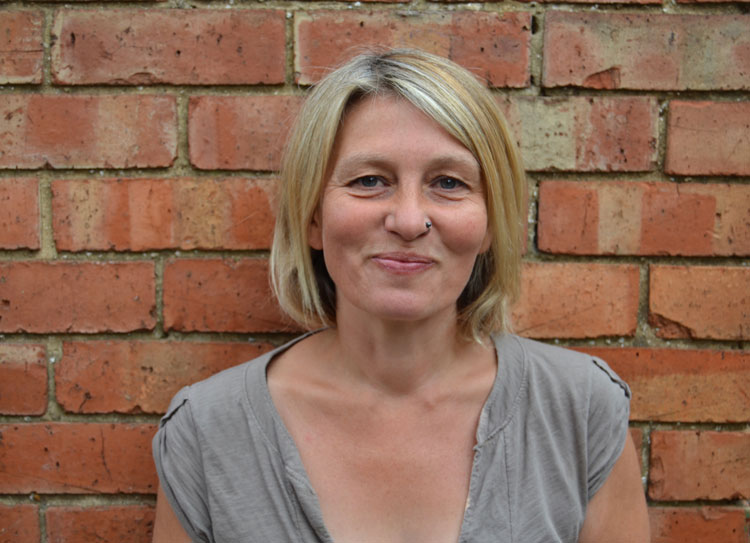
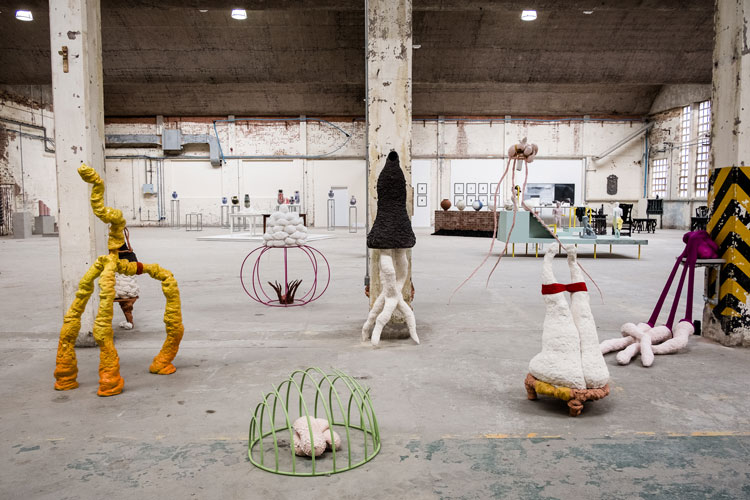
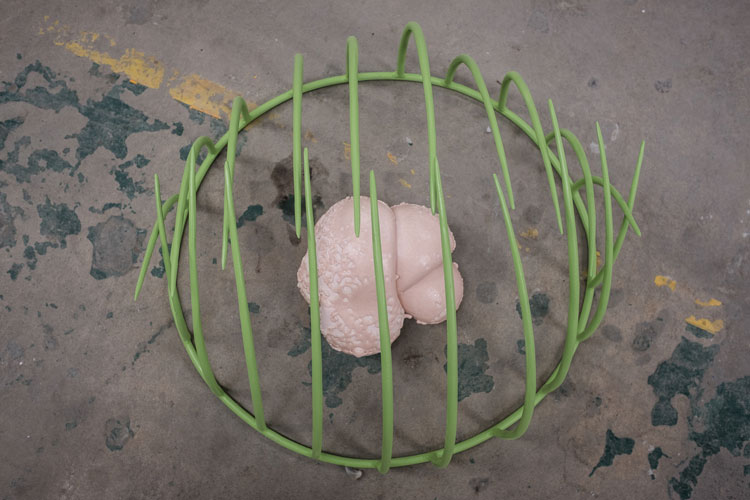
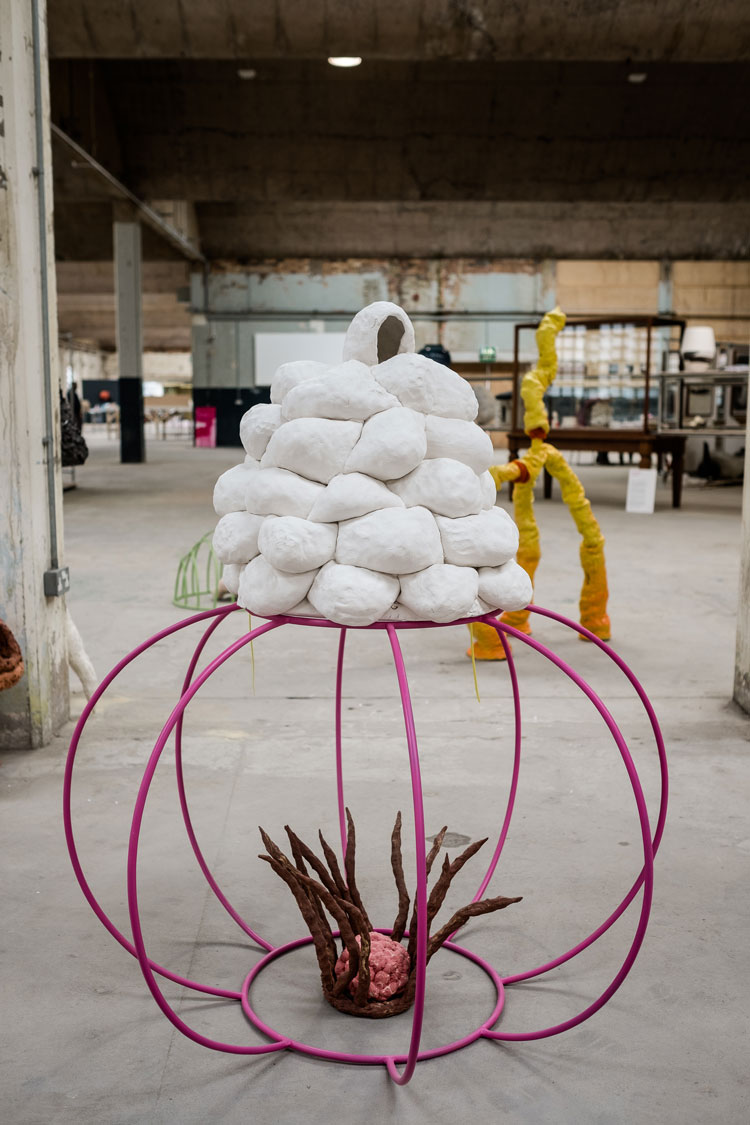
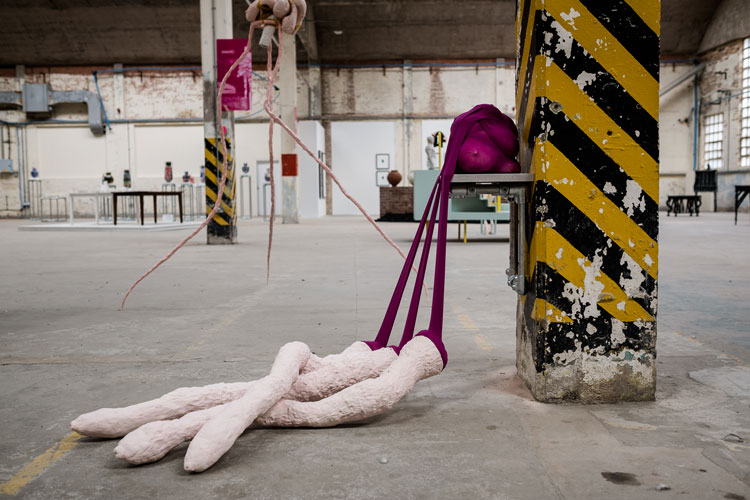
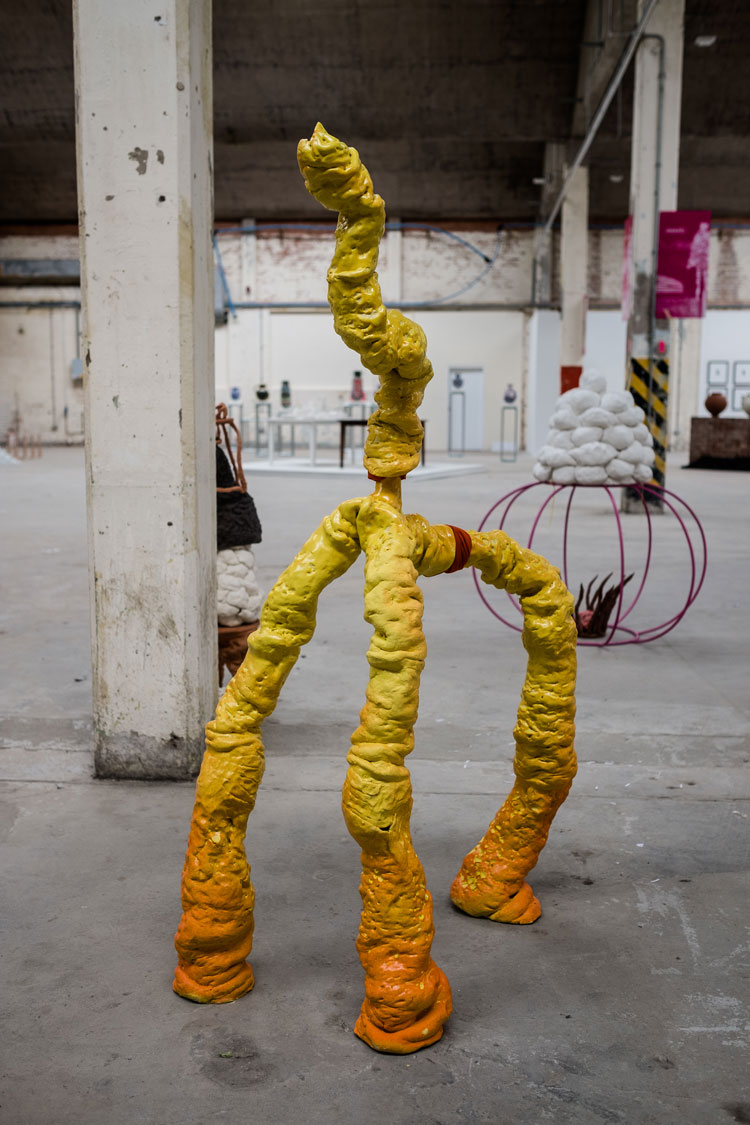
.jpg)
